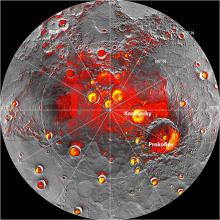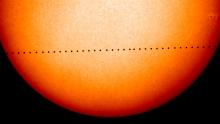Listen to today's episode of StarDate on the web the same day it airs in high-quality streaming audio without any extra ads or announcements. Choose a $8 one-month pass, or listen every day for a year for just $30.
You are here
Evening Mercury
The planet Mercury will lurk low in the evening sky over the next couple of weeks. It’ll lose a little bit of its brilliance each night. But it’ll also climb a little higher in the sky for the next few nights, making it a bit easier to find.
Mercury is the closest planet to the Sun. Since Earth is the third planet, Mercury always huddles close to the Sun in our sky. At best, it’s visible for a little while after sunset or before sunrise. And it spends most of the time in those viewing windows in the twilight.
It takes Mercury just 88 Earth days to orbit the Sun, so it moves across the sky in a hurry. That means you don’t have to look all that carefully to notice that it changes position from day to day.
This week, for example, if you look for it at the same time each evening, in the south-southwest not long after sunset, you’ll see it stairstep up the sky. The planet looks like a bright star, but it can be tough to find in the glow of evening twilight.
By early next week, though, Mercury will be dropping back toward the horizon — and the Sun. And it’ll be getting fainter from night to night, making it tougher to find. It’ll be gone from view by the end of January.
Mercury will cross between Earth and the Sun on February 8th, moving from the evening sky to the morning sky as it does so. And it’ll pull into view by late in the month — cycling across the sky in a hurry.
Tomorrow: rejuvenation for old stars.
Script by Damond Benningfield





